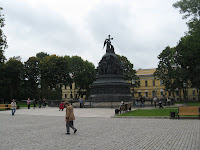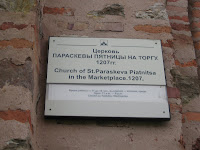 Novgorod was founded in 859 by the Viking Prince Rurik. It is near the River volkhov with convenient connections from Scandinavia to the Aegean, the city of Novgorod became a powerful trading community between 859 and 1478. Ivan the Terrible attacked Novgorod in 1570 and tortured and massacred thousands when the city plotted against him. Novogord declined due to the rise of St. Petersburg. Much of the city's spendor was destroyed in World War II but is now being restored. The first picture is of The Kremlin. It is a fort. The following pictures are what you'll find inside of it. (After the fort pictures there is another big red reader board outlining the history of a village of medieval churches that were situated outside the fort.)
Novgorod was founded in 859 by the Viking Prince Rurik. It is near the River volkhov with convenient connections from Scandinavia to the Aegean, the city of Novgorod became a powerful trading community between 859 and 1478. Ivan the Terrible attacked Novgorod in 1570 and tortured and massacred thousands when the city plotted against him. Novogord declined due to the rise of St. Petersburg. Much of the city's spendor was destroyed in World War II but is now being restored. The first picture is of The Kremlin. It is a fort. The following pictures are what you'll find inside of it. (After the fort pictures there is another big red reader board outlining the history of a village of medieval churches that were situated outside the fort.)BE SURE TO CLICK ON THE BIG RED SIGNS AND IT WILL ENLARGE SO YOU CAN READ THEM.

The gate you enter The Kremlin showing the date is was established.



 In the background is the Millennium Monument. There are more close up pictures further down. This was sculpted by Mikhail Mikeshin and was unvelied in 1862, a thousand years after Rurik's arrival in Novgorod. The figure kneeling before the Orthodox cross is to represent Mother Russia. Just below that is a series of statues that depicts Rurik, Ivan III, Mikhail (the first Romanov tsar), Peter the Great and many others. Surrounding the lower part of the monument are figures of heroes, statemen, artists, princes, chroniclers, and composers.
In the background is the Millennium Monument. There are more close up pictures further down. This was sculpted by Mikhail Mikeshin and was unvelied in 1862, a thousand years after Rurik's arrival in Novgorod. The figure kneeling before the Orthodox cross is to represent Mother Russia. Just below that is a series of statues that depicts Rurik, Ivan III, Mikhail (the first Romanov tsar), Peter the Great and many others. Surrounding the lower part of the monument are figures of heroes, statemen, artists, princes, chroniclers, and composers.
 There are residents of the city that live in these buildings.
There are residents of the city that live in these buildings.

 These bronze doors were seized from the Swedish town of Sigtuna in 1187 after the victory of Novogord.
These bronze doors were seized from the Swedish town of Sigtuna in 1187 after the victory of Novogord.The carvings depict different Bibical stories.


Some of the exterior wall has been removed so visitors can see the original siding of these buildings.

This is St. Sophia's Belfry. It has been altered since it was first built in 1439. The bells were cast in the late 16th and 17th centuries.

Exit gate






 One exterior wall of the fort. The cone-topped towers of the oval-shaped Detinets, or Kremlin, date from the 11th to the 17th centuries. Very sad historical note: According to the practice of those times, the first stone of the original walls was laid on the body of a living child.
One exterior wall of the fort. The cone-topped towers of the oval-shaped Detinets, or Kremlin, date from the 11th to the 17th centuries. Very sad historical note: According to the practice of those times, the first stone of the original walls was laid on the body of a living child. 
 Public beach area outside the Kremlin next to the Volkhov River.
Public beach area outside the Kremlin next to the Volkhov River.
This tall ship is actually made of metal. It looks like wood.
The Kazakh soldiers were fierce warriors and a nomadic tribe with no alligeance to any one group but they aided the numerous Russian tsars in their battles. The Kazakhs are a Turkic people and live in the northern part of Central Asia but are also found in Uzbekistan, China, Russia and Mongolia. We were told by a local that when Stalin came into power he tried to have many of them killed thinking they might be more loyal to the royal families than to him.

This is the sign describing the medieval village outside the Kremlin that once had a medieval market and over 200 churches.

Some of the churches still standing today.







This is Jeanie sitting next to a statue with our shoes kicked off.

Close up of the Millennium Monument that sits in the center of The Kremlin that I wrote about earlier.

Scenes going home. Beautiful fall colors.

Several pictures of "dochas" or homes outside the city. Some people live in them year round and during the summer months grow their own food to live off of. Very humble dwellings. A lot of this area reminded us of Washington.







Apartment building in Novgorod.
 Residential street.
Residential street.


Government building across from The Kremlin


pathway from parking lot to the church

The branch meets in one of the rooms inside this building. Igor explained that the other business/residents of this building do not like the church in the building.














No comments:
Post a Comment